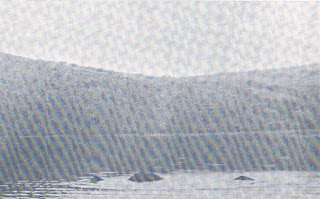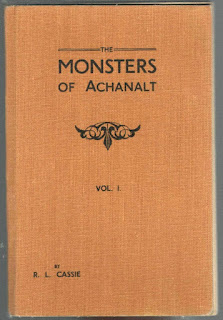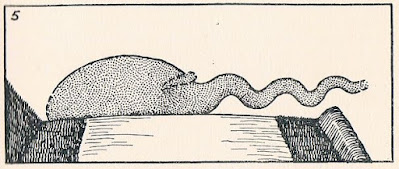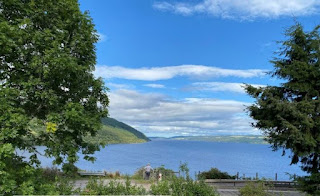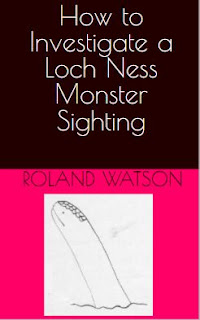Well, so went the headline from the Scottish Daily Record of the 1st November 1972. It concerned a series of photographs taken by Frank Searle which lit up interest in the Loch Ness Monster at that time. I do think things had been rather quiet at the loch up to that point in time. The Loch Ness Investigation had just wound up and who would take up the mantle? However, the Rines Flipper picture had just been published and this kind of photo had not been taken since, well, Frank Searle's previous photograph a year or so before. Mind you, Nicholas Witchell in his "The Loch Ness Story", was to opine a year or so later that the Flipper photo had been upstaged:
And yet, in spite of this, they received surprisingly little coverage when they were released in America by the Academy of Applied Science in November 1972. For some reason they were virtually ignored by the media; perhaps because the announcement coincided with the release of a set of highly ambiguous surface photographs which were splashed across the front page of a popular daily newspaper. They, not unnaturally, made no lasting impression since their source is highly suspect but they did obscure the media's attention and resulted in no more than cursory references to the underwater material.
I think I know what photographs he was talking about, don't you? Now this could become a rather short article if we just do the normal thing and declare it a fake, quickly conjure up something vaguely resembling an explanation of how he did it and move on to something more interesting. But I don't think I have seen a detailed analysis of his photos. Besides, whatever the outcome, this post is perhaps directed at someone other than Frank Searle, which I shall explain at the end. So for now let us treat it like a normal sighting report and take it from there. First we have the account from the Daily Record:
The loch was calm in the cool evening air. Then, suddenly, there was a tremendous splash and Nessie reared out of the water. At least, that's how monster hunter Frank Searle tells it - and he's got pictures to back it up. Last night at his lonely camp on the shores of Loch Ness, I talked to Frank about the pictures which are sure to start a "is it or isn't" controversy.
"Look" he said "I've known all along there was a monster in the loch. I've even got pictures four times before - but - this time they're the best yet."
More than three years ago Frank quit his London job and moved to Loch Ness to become a full-time monster watcher.
"I spend up to 19 hours a day" he said "either out in my boat or just watching the loch."
Ten days ago he was out in his boat, when it suddenly happened.
"The loch was very calm" he said "It was a beautiful evening. Then suddenly there was this tremendous splash and the monster appeared. I grabbed my camera and banged off four shots. I could hardly believe it. I know I had the monster's head, neck and one or two humps. It set up a huge set of ripples and then moved forward out of them."
Frank went on "The wake started from the body, and I got the impression there were big flippers near where the neck and body met. After about 20 seconds, the monster dived. Then, about two minutes later, it reappeared on the other side - it had obviously passed right under my boat. It didn't raise its head or neck this time, but I got another six shots in the half-minute it stayed in sight."
He described Nessie as "blackish and rough with one or two humps showing. It seemed to have a bump or bumps about its forehead."
Five years later, Frank Searle adds further details of this story in his autobiographical book, "Nessie - Seven years in search of the Monster". The incident happened on the 21st October and I reproduce the text from page 38-41:
Gradually things quietened down. I continued the search. Of all the newspapers who'd interviewed me, only one, the Daily Record sent a contribution to my funds. With that money I bought a much larger tent and a second-hand outboard engine. Local enthusiasts were visiting me at regular intervals to find out if anything else was happening. They were also directing visitors to me who asked about Loch Ness in local pubs, shops, guest-houses etc. On August 11th at 9 p.m. I had a long-distance sighting near Tor Point. Too far off for a picture, but seven motorists parked on a lay-by on the opposite side of the Loch saw both the creature and my boat heading towards it.
Summer gave way to autumn, the days shortened. On October 19th, an Australian school-teacher came to Inverness. She had a month's holiday and had come up to get information about the Loch Ness Monster for a school project when she returned home. She stayed the night at a guest house whose owner knew of me. When she started asking about Loch Ness she was told, "Go out and see the man in the tent." So next morning, this attractive twenty-three-year-old Aussie arrived at my site. She saw my picture, newspaper cuttings etc. I told her all I knew about Loch Ness and she was fascinated. Then she simply said: "I've got a month's holiday. Can I stay with you?" Well! What man turns down offers like that?
And anyway, she made good coffee. So she went and collected her gear and moved in. Next morning, when I would normally have taken the boat out at first light, it was pouring with rain and the visibility was terrible. So we stayed in. It was almost 2 p.m. before the weather improved and off we went, away up the Loch towards Foyers. The water was fairly calm but nothing showed. Around 6 p.m., the sun dipped behind the hills and the light began to fade. We were then near Urquhart Bay. I said: "Well, that's it for today. We'll head back for some food," and turned for home.
And suddenly, there it was! Some six hundred yards to one side of the boat, head and neck out of the water in front of a large hump. I got four pictures and then the thing slid below the surface with hardly a ripple. I swung the boat round in a big circle, camera at the ready. Nothing, until the circle was almost complete, then there, on the other side of the boat was a big black hump and in front of it a small hump which was probably the top of the head. I got two more pictures, turned the boat towards it. The beast turned away, set up a large wake, then disappeared. By now, the light was really bad. I cruised around for a few more minutes. Nothing showed. I turned towards my site. And only then did I realised that I hadn't heard a word from my guest.
She was sitting there absolutely shaking from head to foot. Her little Instamatic camera still lay on the seat. I had to shout at her before she even looked at me. We got in, I pulled the boat up. She just walked up to the tent without a word. When I'd tied up the boat and followed her, she was sitting there still shaking. All she could say was, "I did see it, Frank, didn't I?" Over and over again. Next morning we sent the film off. I knew I'd got something this time. When the pictures came back we were delighted. The bad light had killed any chance of detail at that distance but the shape was clear and I'd got good background. One picture showed the creature's mouth wide open.
I remembered the newspapers that hadn't sent me a small contribution after the last sighting, then for-got them, and gave an exclusive to the Daily Record and its sister paper in England, the Daily Mirror. The result was sensational. The Record gave its entire front page to the best picture with huge headlines, "The Most Amazing Pictures Ever Taken". And more inside! Other newspapers, magazines, television, came to interview me. One T.V. interviewer asked my companion how she'd come to be there. She explained how she'd been sent to see me, how she'd been fascinated with the information and had asked if she could stay. "Frank said 'Can you make good coffee, darling?' " she laughed. "I said yes I could, and he said, 'Well, come in and put the kettle on.'
I have managed to find all of the six photographs Searle claimed to have taken on that day. He took four snaps of a long necked object with a hump, then circled his boat, whereupon he says, it surfaced on the other side and he took the final two shots (or six according to the newspaper report).They are shown below in what I think is chronological order, although the print quality varies. Photo one is the most reprinted and the best quality of the first four. Numbers two and four are courtesy of Henry Bauer who took them on cine film when he visited Frank Searle's exhibition hut, where they were on display. The final two come from Searle's book.
Let's check out a few things first. Frank said he had headed south from his base at Balachladaich towards Foyers and by 6pm he was near Urquhart Bay when it was getting dark. On October 27th, the sun sets about 1745 which is consistent with that statement. The hills in the background are also place the photographer near Urquhart Bay. Where exactly is less easy to ascertain. Using "Google Boat" or Google's aquatic version of Street View at Loch Ness, the map and view below gives one possible spot with the arrow suggesting it may have been further to the centre of the loch.
This correlates reasonably well with this wider shot below of the best known picture of this sequence. It was more difficult to line up the opposite shore as we basically have just a dip between two hills and that occurs everywhere. One could try and match up terrain features against modern images but with fifty years having passed, fields and forests can change beyond recognition. So where this was taken is an open question and for now we just assume it is the opposite side looking to near Whitefield.
What one can say is that the hills on the Urquhart Bay side look darker than the ones on the opposite side. This is done by comparing various versions of photographs of the two sides, since the same scene can have a different contrast in another picture, we need to look at them in the round. This being the case, this observation is also consistent with the reported time as the sun would be setting behind the Urquhart Bay hills, moving them into silhouette. Meantime, the sunlight would still be illuminating the hills on the opposite side.
So, we could say with some confidence that Frank Searle was where he claimed to be at the stated time. Now we move onto the object itself. As you can see from the first four pictures, there is a large hump followed by a smaller hump and then a long neck and a head with an apparently open mouth. The other curious feature is a smaller third hump which appears from the second picture on the left and then appears to adjoin itself to the main body. Frank says nothing about this third hump despite its anomalous behaviour marking it out for attention. We will revisit this later.
The charge is then made that the alleged head and neck do not budge an inch during the sequence of four pictures suggesting they are inanimate. Now it is clear they do not move in any significant way but even the slightest movement would negate the word "inanimate". One way to achieve that would be to overlay the four pictures shown and look for subtle differences. The overlay below is of the first and fourth pictures and demonstrates the analytical problem. The first image is good but the rest are poorly reproduced, making subtle comparisons problematic. There may be a change in head-neck position below, but it could also be due to problems in aligning the images due to blurriness.
We then have the two pictures from the other side of the boat which shows a main hump and a smaller hump - claimed to be the head by Frank Searle. The object then seems to move as indicated by the wake being generated. The main observation here is that the main hump of the last two pictures does not look like the main hump of the first four pictures. The last one is semi-circular in form while the first looks like a semi-circle with a smaller semi-circle on top. Once again, Frank doesn't make a comment on this. In fact, he generally does not go into any detailed analysis on his photographs.
What I have seen is that nobody denies that the object photographed is actually there. One could argue the object is overlaid into the original print and rephotographed. However, that would seem to be unlikely as one can observe reflections on the surface of the water from the main hump in the first photograph as well as in the area of the alleged head and neck. So we will proceed on that assumption as did Steuart Campbell when he analyzed this photograph for the Winter 1982-83 issue of the Sceptical Enquirer magazine (volume 7 issue 2).
The article was entitled, "The 'Monster' Tree-Trunk of Loch Ness", and it was clear where Steuart was heading with this. He had been prepared to give Searle the benefit of the doubt back in the 1970s and that perhaps one or two of his pictures were genuine, but not this one. Eight years after the pictures were taken, Steuart made contact with James Menzies, who owned Temple Pier and lived there. Mr. Menzies made his view of the photo clear:
During our first conversation, in 1980, I asked Menzies about Searle and his photographs. He said that he had seen a large branch or a tree trunk drift into Urquhart Bay from the River Enrick on the day Searle took these pictures. When, in July 1981, I showed Menzies the first photograph taken by Searle (Figure 1), he identified it as a picture of the tree trunk he had seen in 1972. In his book, Searle admitted that there had been heavy rain earlier that day; it would not be surprising, therefore, if some portion of a tree had been washed down the flooded river.
The rest of the article mainly runs along those lines, with an extra analysis by a Charles Cazeau who suggests the lack of water disturbance around the object is again indicative of a dead tree trunk. He also claims the object is "slowly rotating", a claim that I cannot verify from the images I have. Steuart also points out that Searle had by then stopped a photograph agency from selling prints of the six pictures. Why he did this was not initially clear to me.
Accusations that Searle contrived various pictures as logs and branches is a common enough charge. Others suggest he used specially prepared models or he simply overlaid cut outs onto empty scenes - as with his infamous brontosaurus picture. But going back to the tree theory, I must admit, whatever one may think about Frank Searle, that does not look like a tree trunk to me. But Andrew Menzies said he saw a log like it on the same day, right? There are a couple of things that could make me doubt this. Going back to Steuart's conversation with Menzies,
Mr. Menzies said in 1980 he saw a large branch in the bay on the day of the Searle pictures. How did he know it was on the day of the pictures? The only source I know of was the Daily Record article (and its sister newspaper, the Mirror) which gave the date when it printed eleven days later. So I assume he saw the article, in which case, why did Steuart have to show him the photo on the second visit to confirm it? After all, the picture was on the front page. The fact this was happening nearly nine years after the event does not make me confident of perfect recall about what a tree branch looked like in 1972. I say that because Nessie sceptics would have no problem querying eyewitness recall after such a long time. However, they also have no problem accepting testimony against eyewitnesses without any similar querying.
But that seemed to be the least problem. I go back to that strange hump object moving from left to right. So how exactly does a tree trunk or branch account for that? It cannot as one would deduce if it was part of the trunk, it would stay in the same position relative to the rest of the trunk. Moreover, if this hump like part of the tree were to emerge from the water, i.e., bob up, I would expect an opposite and equal reaction as something bobs down, such as the alleged neck. As it happens, nothing else moves in any direction.
A look around at other sceptical views had Ronald Binns coming to the same conclusion, that it was a tree trunk and he even claimed to spot a branch sticking out of the second hump. I have had a good look at the best images I have but cannot see such an item. As a side note, Andrew Menzies is mentioned in another story from Loch Ness lore and that is the land sighting by Arthur Grant in 1934. Menzies claimed he overheard Grant admitting to hoaxing the story. I examine that claim in my book on land sightings - but back to Frank Searle. So, have we managed to soften your attitude to Frankie boy a bit? Let us now rewind and go back to pictures one and three shown below.
I now direct your attention to photograph three with some lines drawn in to highlight some waves.
The next book to be consulted was Frank Searle's "Around Loch Ness" published later in 1977. The same photograph was found and is reproduced below.
You may have noticed that there is something missing. The rightmost hump is gone, so perhaps this is a different picture? Unfortunately not, as an another examination of the water patterns around the humps conclusively shows it is again the same photograph. The only question is whether the hump was removed from the original image or was added to the original image? Since it is easier to overlay an image than delete part of an original, it was surely added to unoccupied water.
And therein lies the mystery of the migrating third hump in the second to fourth photos. It was likewise an acetate overlay or similar added three times. In fact, the clue to this is the fact that the other two humps and head-neck cast some form of reflection on the water, whereas our moving hump presents a clean straight line with the water surface (see image below). Now we know why Frank stopped copies of these photos going out when the expose of him began, researchers would have obtained quality copies and found them to be wanting.
The only open question is what constitutes the main objects in the first four and last two pictures. Is it a strange looking tree trunk, a model or something else? As stated, they are not the same shape and one could invoke the famous shifting humps of the monster, but we are not at the level of confidence in these pictures to proceed anywhere near such speculations. The pictures have been doctored and because of this we need to back off and proceed no further. Nevertheless, it still doesn't look like a tree trunk to me, but who knows? If the original picture was of a monster, he destroyed any trust in it by overlaying it with fakery.
Which brings me to the final part and perhaps the main reason for this article. In all of this drama, we almost forgot about the young lady who Searle tells us was on the boat. It was another of his Girl Fridays who was great at making coffee. I would think making great coffee was a euphemism for something else. Did Frank like his coffee granulated or percolated? Best not to ask.
You may think that this woman was as fictional as Frank's photographs, but apparently not. In Frank's unpublished work, "Loch Ness Investigation - What Really Happened" she is named as Carole Kennard, an Australian school teacher aged twenty three at the time. Frank goes over the Urquhart Bay incident again but alleges that three members of the Loch Ness Investigation Bureau came with a request to borrow the negatives:
While I am on the matter of finding Frank Searle's girlfriends, I also mention a Miss Lynda Tate, a student from Yorkshire, whom Searle claimed co-witnessed another photograph he took on July 9th 1974. Let us see where these matters take us.
Comments can also be made at the Loch Ness Mystery Blog Facebook group.
The author can be contacted at lochnesskelpie@gmail.com














